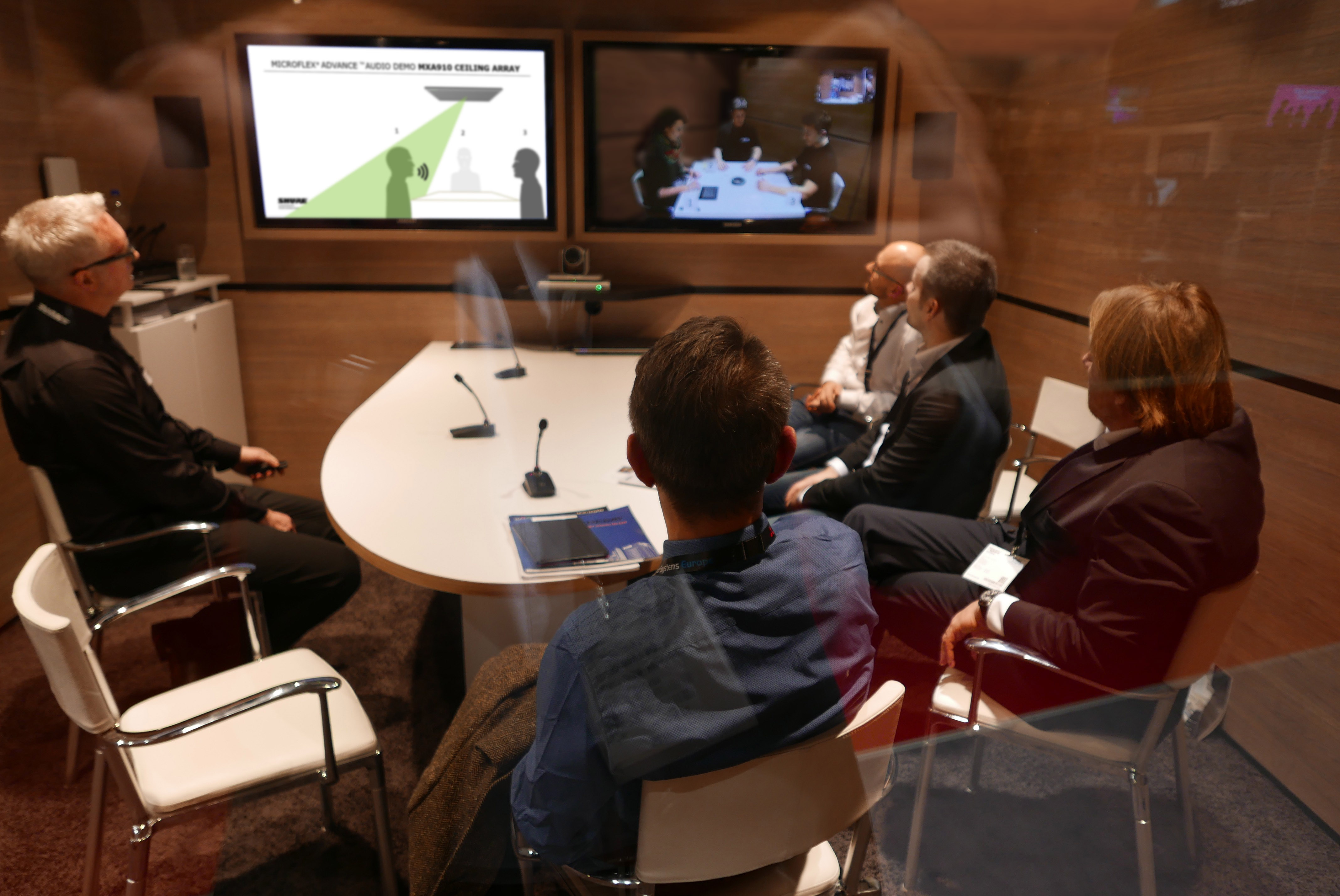
With a sleek, elegant design and a whole new polar pattern, the Microflex Advance is set to change the face of audio video conferencing, Joanne Ruddock finds out more.
Promising ‘innovative new technology’ and ‘pristine speech intelligibility’, the arrival of the Microflex Advance from Shure was one of the highlights of ISE 2016.
The new premium network solution is designed specifically for audio-video conferencing, whether that’s in a high-end executive boardroom, general meeting room, huddle room, or other similar space.
The demo suite in this case consisted of a huddle room-style meeting area featuring a MXA910 ceiling array microphone and a MXA310 table array. General system features that apply to both these products include the IntelliMix DSP suite and Dante digital audio networking. IntelliMix DSP suite and Dante digital audio networking.
The IntelliMix DSP suite, used in Shure’s range of automatic microphone mixers, now includes Steerable Coverage technology, which enables the configuration and control of accurate polar patterns in any area of a meeting space.
The microphones have a single Ethernet jack on them: that one cable carries all the Dante audio, all the control signals and the power – they are powered by standard PoE. On the control side they feature a built-in browser–based software for set up and configuration. They can store up to 10 device presets which can be saved, loaded, imported and exported for later use. The microphones also feature preconfigured templates for easy, quick set up depending on the room type being used. Also important is compatibility with third-party control systems so Shure uses Ethernet commands to communicate to audio DSPs or control systems meaning the mics can be controlled via touchpanel.
Both the Table Array and the Ceiling Array come in three colours – black, white and aluminium. The ceiling array can also be painted.
Table Array
The main feature of the Table Array is its new polar pattern, the toroid, which picks up everybody who is seated around the table but does not pick up from anything overhead. So if the room suffers from projector fan or heating/cooling system noise this pattern rejects overhead noise while optimising the voices of participants.
Ease of set up and ease of use is central to the design. The Table Array offers configurable coverage and has capacitive touch mute capability which can be software programmable so users can set it in the software – whether it’s toggle push to talk, push to mute. It is also possible to disable the muting function if you’re just going to be muting from your touchpanel.
The Table Array comes with a highly configurable full RGB LED light bar. Users can chose from a wide range of colours via software. It is also possible to turn the light off, dim, flash or even change it from showing the full colour ring to just showing segments to indicate where the pick up of the microphone is aimed.
As a digital intelligent microphone all the parameters of the Table Array are changed through software, including the polar pattern. The coverage area for up to four areas can be set in 15º increments and the polar pattern specified for each configuration, be that omnidirectional, cardiod, bidirectional, toroid etc.
Ceiling Array
When it comes to the ceiling array, the mounting options are certainly worthy of a mention. The unit can be suspended thanks to built in anchor points and it has a VESA mounting plate so it can be hung via any universal mount in the same way as a projector. However, perhaps the easiest option is to fix it in a drop tile ceiling – if you have this type of ceiling it is simply a case of taking out the tile and putting in the microphone.
Another point to note is that the pickup of this microphone is not a traditional polar pattern, it’s very directional and very narrow – narrower than a shotgun mic. However it’s also adjustable in the software so it is possible to choose between a narrow, medium or wide pick up. Once this is done it can be aimed anywhere you want: not only can you change the x and y position, you can also change the height of where it’s aimed. This is particularly useful if you have a talker at a podium as opposed to seated at a conference table as it can be aimed directly at the talker’s mouth.
Up to eight individual lobes can be configured and positioned wherever needed. And, similar to the Table Array, each of those eight is its own Dante channel which means they can be routed to an audio DSP and processed individually.
So what’s the capability performance for the Ceiling Array? Shure uses the STIPA (Speech Transmission Index for Public Address) scale to measure intelligibility and, according to the manufacturer’s results, in an average type of room when installed at a height of 3m it can capture audio from seat of purchase out to a 9m diameter. This doesn’t mean that that’s any kind of limit but rather that anywhere within that 9m diameter will mean a STIPA A rating. This rating can be maintained up to a height of 5m above the talker.
In Use
The demo itself was carried out in a huddle room-sized space split into three quadrants with a talker in each quadrant controlling the mics via touchpanel.
The first stage of the demo featured a Shure Table Array set to bidirectional pattern pointed at quadrants one and three before being switched to quadrant two only in order to show the difference in speech intelligibility – as expected the audio was much clearer from the quadrants the mic pointed at.
It was then switched to an omnidirectional pattern pointed at quadrant two. Again a talker in each quadrant demonstrated the differing levels of intelligibility before a noise source was turned on to simulate projector fan noise or heater/ventilation noise creating interference in each quadrant.
The system was then switched to the new toroid pattern resulting in a clear and immediate reduction in interference from above. As the mics were switched back and forth between omni and toroid it became increasingly clear how much overhead noise was rejected – in the omni pattern it was a strain to hear what was being said; in toroid voice clarity was much higher across all quadrants.
Next the Ceiling Array, mounted at a height of 2.7m, was tested. With one lobe pointed at a speaker audio was clear due to the narrower pickup pattern, but other participants sounded more distant. As lobes were pointed at different speakers their speech clarity improved significantly.
The demo then switched between the Shure Ceiling Array with one lobe directed at speaker one and the ceiling mounted MX202 omnidirectional mic to highlight the different polar pattern behaviour.







